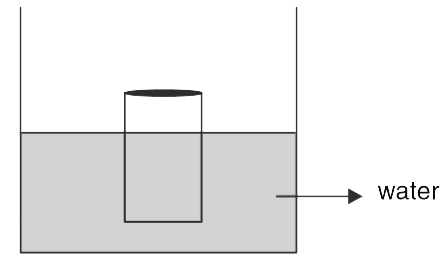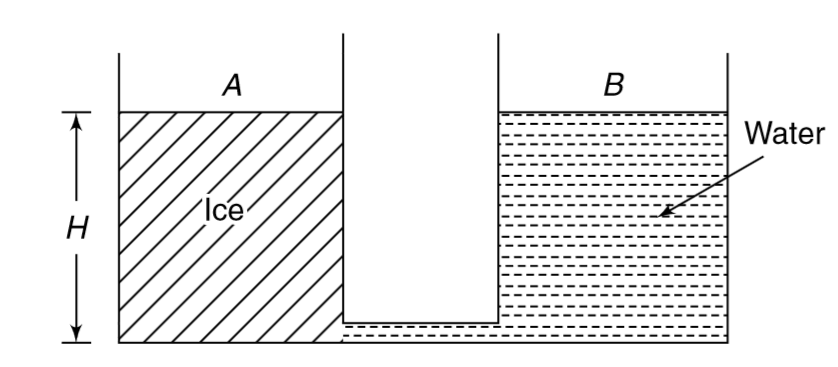Srisha wanted to keep ice creams without melting. So he had to keep it on ice taken in a container. His grandmother advised him to pour salt on the ice.
(a) Why? (b) What is the value in this?
Step-by-Step Solution:
1. Understanding Freezing Point Depression: When salt is added to ice, it lowers the freezing point of water. This phenomenon is known as freezing point depression, which is a colligative property of solutions.
2. Colligative Properties: Colligative properties depend on the number of solute particles in a solution, rather than the identity of the solute. In this case, the salt (solute) increases the number of particles in the solution.
3. Effect of Salt on Ice: When salt is sprinkled on ice, it dissolves and disrupts the equilibrium of the ice-water system. The melting point of ice is normally 0°C, but the presence of salt causes the ice to melt at a lower temperature.
4. Resulting Temperature Change: As the ice melts at a lower temperature, it absorbs heat from the surroundings, including the ice cream. This results in a colder environment around the ice cream, helping to keep it from melting.
5. Conclusion: Therefore, by adding salt to the ice, the temperature of the ice is lowered, which helps keep the ice cream from melting quickly.
(b) What is the value in this?
1. Respect for Elders: The advice given by Srisha's grandmother highlights the importance of listening to and respecting the wisdom of elders. They often have experience and knowledge that can help in practical situations.
2. Scientific Understanding: This scenario also teaches the value of understanding scientific principles, such as colligative properties and freezing point depression, which can be applied in everyday life.
3. Problem-Solving: It encourages critical thinking and problem-solving skills, as one learns to apply scientific concepts to solve real-world problems, like keeping ice cream from melting.
---
Similar Questions
Bharath went to his grandfather’s house in winter this year. As usual he went for fishing. His grandmother told him there will be no fishes in the lake. He noticed that it was more difficult to find fishes in winter. The fishes were deep inside the river. Whereas in summer they were on the surface and hence he was able to catch fishes.
(a) Why are fishes on the surface in water than in the depth in summer?
Srisha wanted to keep ice creams without melting. So he had to keep it on ice taken in a container. His grandmother advised him to pour salt on the ice.
(a) Why? (b) What value can be derived from this?View SolutionWhile making homemade ice cream, salt is added to the ice in the container. Why?
View SolutionBunty was fond of painting. He observed that hairs of paint brush do not cling together when dry and even when dipped in water but form a fine tip when taken out of it. He was quite surprised to see it but found it very useful for doing neat and beautiful painting. He asked his elder sister Shanti, who was a science student of class XI, that why do hairs of a paint brush cling together when taken out of water. His elder sister explained him the reason nicely.
(i) What are the values displayed by Bunty here?
(ii) Why do the hairs of a paint brush cling together when taken out of water?\View SolutionA cyclindrical ice block is floating in water 10% of its total volume is outside water. Kerosene oil (relative density=0.8) is poured slowly on top of water in the container. Assume that the oil does not mix with water. Height of the ice cylinder is H.

(a) As kerosene is poured, how does the volume of ice block above the water level change?
(b) What is the thickness of kerosene layer above the water when 20% of the volume of the ice block is above the water surface?
(c) Find the ratio of voume of ice block is kerosene to its volume in water after the kerosene layer rises above the top surface of ice and the block gets completely submerged. Neglect any melting of ice.View SolutionTwo identical cylindrical containers A and B are interconnected by a tube of negligible dimensions. Container A is filled with an ice block up to height H = 1.8 m and container B is filled up to same height with water. Ice is at 0∘C and water is at 40∘C. Due to heat exchange between water and ice, the ice block begins to melt. Assume that the ice block melt in horizontal layers starting from the bottom. The thickness of ice block reduces uniformly over the entire cross section of the container. The ice block moves without friction inside the container and no water enters between the vertical wall of the container and the ice block. Heat is exchanged only between the ice block and the water and there is no heat exchange with containers or atmosphere. Calculate the height of water in container B when thermal equilibrium is attained. Relative density and specific latent heat of fusion of ice are 0.9 and 80calg−1 respectively. Specific heat capacity of water is 1calg−1.∘C−1.
 View Solution
View SolutionA group of students went for an excursion to Shimla in the month of November. A science teacher also accompanied them. There the temperature fell to −10∘C. They took some ice cubes and subjected them to heating while keeping a thermometer in the container. The students monitored the readings of thermometer till the entire ice melted into water. All of them went to their science teacher and showed him their observations. He asked them to discuss among themselves and give a proper justification for the observations on the readings at various stages.
View SolutionA group of students went for an excursion to Shimla in the month of November. A science teacher also accompanied them. There the temperature fell to −10∘C. They took some ice cubes and subjected them to heating while keeping a thermometer in the container. The students monitored the readings of thermometer till the entire ice melted into water. All of them went to their science teacher and showed him their observations. He asked them to discuss among themselves and give a proper justification for the observations on the readings at various stages.
View SolutionNotice the following expressions. The highlighted words are not used in a literal sense. Explain what they mean.
1. Words had to be prized out of him like stones out of a ground.
2. Sophie felt a tightening in her throat.
3. If he keeps his head on his shoulders.
4. On Saturday they made their weekly pilgrimage to the United.
5. She saw… him ghost past the lumbering defenders.View SolutionMr. Firoze is a retired man who lives in a big house. He has recently replaced all the filament-type bulbs in his house by CFls. His wife and children have a habit of keeping the lights and fans on (even when there is no one in the room) but Mr. Firoze keeps on going to every room periodically to switch them off. A few days back Mr. Firoze had purchased a device which can cook rice and dal without using any usual fuel. He has also installed an equipment on the roof of his house to obtain hot water. Mr. Firoze uses bicycle for short distances like going to nearby market, instead of scooter or car.
(a) What is CFL ? Why has Mr. Firoze replaced all the filament-type bulbs in his big house by CFLs ?
(b) Why does Mr.Firoze keep switching off lights and fans when no one is in the rooms ?
(c) Name the device which Mr. Firoze has purchased to cook rice and dal without using any usual fuel ?
(d) Name the equipment which Mr. Firoze has installed on the house-roof to obtain hot water ?
(e) Why does Mr. Firoze use bicycle for going through short distances ?
(f) What values are displayed by Mr. Firoze by all the above actions ?View SolutionDue to hectic and busy schedule, Mr. Angad made his life full of tension and anxiety. He started taking sleeping pills to overcome the depression without consulting the doctor. Mr. Deepak, a close friend of Mr. Angad, advised him to stop taking sleeping pills and suggested to changes his lifestyle by doing Yoga, meditation and some physical exercise. Mr. Angad followed his friend's advice and after few days he started feeling better.
After reading the above passage, answer the following :
(i) What are the values (at least two) displayed by Mr. Deepak?
(ii) Why is it not advisable to take sleeping pills without consulting doctor?
(iii) What are tanquilizers? Give two examples.View Solution

